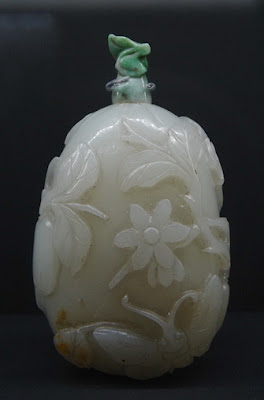Here are some of the items in the collection. They are all between 2 and 4 inches tall.
(My own collection, I am happy to say, is smaller but no worse in quality).
Category 1. Painting on glass. This is done with a curved brush on the inside surface of the bottle. (Calligraphic inscriptions must therefore be executed in mirror image).




Category 2. Camoes. These are pietre dure (i.e. semi-precious stones) carved in cameo technique. (Cameo technique consists in carving a two-layered stone in such a manner that one, upper layer is reduced to mere pattern upon the flat surface of the other, lower layer).


Category 3. Porcelain.





Category 4. My favorite: pietre dure.





Category 5. This is a very special piece (first time I see this technique): a bottle carved in a semi-precious stone then decorated in fen-cai, (that is decoration painted in overglaze paint and fired as if it the piece were porcelain):

Category 6. Painted enamel on copper.

Category 7. Ivory





No comments:
Post a Comment